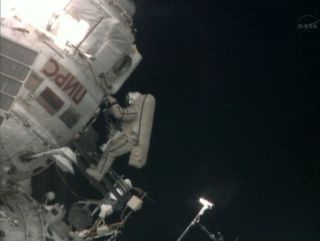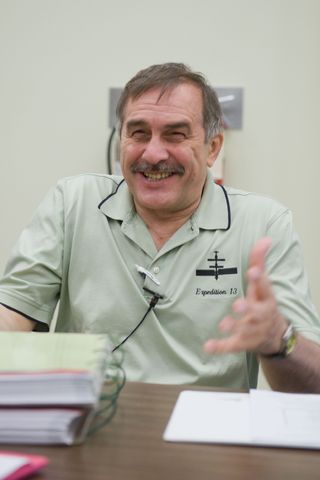World's Oldest Spacewalker: Russian Cosmonaut Makes Space History at 59

Russian cosmonaut Pavel Vinogradov made spaceflight history high above Earth on Friday (April 19) when, at age 59, he became the oldest person ever to venture outside a spacecraft during a spacewalk that was only marred by the last-minute loss of an experiment.
Vinogradov, a veteran cosmonaut, took his seventh cosmic excursion in 16 years during Friday's spacewalk. He donned a bulky spacesuit and left the confines of the International Space Station just after 10 a.m. EDT (1400 GMT) to upgrade the orbiting lab with new experiments.
Vinogradov paired up with 41-year-old fellow cosmonaut Roman Romanenko, a first-time spacewalker but second-generation cosmonaut. Romanenko's father, former cosmonaut Yuri Romanenko, logged more than 10 spacewalking hours in his career.

The spacewalkers were at times lighthearted during the more-than-six-hour job.
"Nobody took a photo of me," Romanenko jokingly protested aftering they used a camera to take pictures outside the lab. "How can it be like that? Please take a photo of me, Pavel."
In the last task of the spacewalk, Vinogradov was attempting to retrieve a panel from the Russian materials exposure experiment called Vinoslivost, but the panel flew out of his grasp before he had a chance to tether it. The cosmonauts were unable to recover the piece.
Flight controllers do not believe the 6.5-pound (3-kg) panel, which measured 18 inches by 12 inches (45 cm by 30 cm), hit any part of the space station. NASA announcers noted that there is another Vinoslivost panel still attached to the space station that will be retrieved in a future spacewalk, so all is not lost from the experiment.
Get the Space.com Newsletter
Breaking space news, the latest updates on rocket launches, skywatching events and more!
Vinogradov and Romanenko's primary objective was to install a new Russian experiment called Obstanovka, which will measure charged particles interact with a variety of materials kept outside of the space station. Obstanovka could offer scientists new insights about how space weather affects the ionosphere, an active region of the Earth's atmosphere, NASA officials explained in a spacewalk description.
The pair also successfully retrieved a Biorisk canister, an experiment that measures the effects of bacteria and fungus on spacecraft materials, and prepared the outpost for the arrival of a robotic cargo ship later this year.
The spacewalkers are two members of the six-man Expedition 35 crew currently living aboard the International Space Station. The others are Canadian astronaut Chris Hadfield, Russian cosmonaut Alexander Misurkin, and NASA astronauts Thomas Marshburn and Chris Cassidy.
This was the 167th spacewalk dedicated to the construction and upkeep of the International Space Station, which was built by five different space agencies representing 15 countries. Construction of the $100 billion space station began in 1998, and it has been permanently staffed with rotating crews since 2000. It is roughly the size of a five-bedroom house with a wingspan the size of a football field.
Follow us @Spacedotcom, Facebook and Google+. Originally published on SPACE.com.
Join our Space Forums to keep talking space on the latest missions, night sky and more! And if you have a news tip, correction or comment, let us know at: community@space.com.

Megan has been writing for Live Science and Space.com since 2012. Her interests range from archaeology to space exploration, and she has a bachelor's degree in English and art history from New York University. Megan spent two years as a reporter on the national desk at NewsCore. She has watched dinosaur auctions, witnessed rocket launches, licked ancient pottery sherds in Cyprus and flown in zero gravity on a Zero Gravity Corp. to follow students sparking weightless fires for science. Follow her on Twitter for her latest project.
